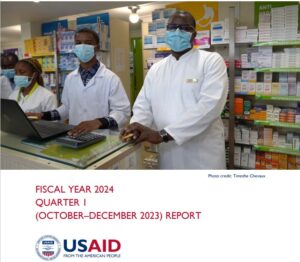Strong supply chain systems ensure uninterrupted availability of life-saving medicines and other health technologies for successful achievement of global goals, such as ending the HIV/AIDS epidemic, TB and malaria elimination, preventing maternal and childhood deaths, responding to health emergencies, and improving health outcomes overall.
Ensuring the uninterrupted availability of quality-assured medicines and health technologies from the manufacturer to end users is the ultimate goal of pharmaceutical supply chain systems. However, strategies to strengthen key supply chain components are inadequate in many low- and middle-income countries (LMICs), and systems cannot effectively manage local and global health program demands. Furthermore, the surge of new epidemics/pandemics such as COVID-19, the introduction of new medicines and technologies, and the need to adapt to new delivery strategies strain already challenged systems.
Through MTaPS and other programs, USAID provides technical assistance to improve the countries' supply chain systems. Implementing an effective and efficient supply chain management system involves putting good supply chain governance with clear structure in place; strategically planning, designing, and implementing all functions and related processes; investing in human resources and institutional capacity to effectively and efficiently manage the supply chain systems; and developing and implementing comprehensive information systems.
MTaPS supports ministries of health (MOHs), donors, and supply chain stakeholders to design and implement resilient supply chain management solutions that lead to self-reliance through county-led initiatives and local capacity building.
MTaPS helps countries:
- Conduct stakeholder mapping of supply chain systems, establish/strengthen a supply chain governing body with identified stakeholders, and assist that body to develop a political strategy/supply governance plan (example, as in the Philippines)
- Strengthen supply chain governance capacity to set clear rules and structures and disseminate information in collaboration with Global Health Supply Chain partners
- Integrate supply chain functions from the central level to the point of care for health commodities and develop and execute the integration plan, including change management, tools, training, and information systems
- Support the whole market view of medicine availability by incorporating data on private-sector procurement and consumer purchasing behaviors and developing a strategic plan, including market segmentation, to improve resource use
- Assess and implement end-to-end information systems for supply chain through detailed user and system requirement studies, global standards, and global digital health guiding principles
- Provide electronic logistics management information system (eLMIS) solutions to manage emergency commodities' supply chains during emergencies and in times of pandemic, such as COVID-19
- Support improvements in data analytics, data use culture, dispensing, and product management practices at the point of care, including the use of electronic dispensing, stock management, and transaction management tools
- Support policy options analysis to develop a long-term investment plan to optimize a combination of domestic manufacturing and international procurement that will improve essential medicines availability and affordability
- Adopt the World Health Organization’s new essential diagnostic list, essential medicines lists, and overall health technologies
- Assess supply chain system inefficiencies and provide alternative management practices
- Build their capacity to improve the quality of procured medicines and other health technologies, designate technical specifications of medicines/products, establish manufacturer prequalification processes in collaboration with the national medicines regulatory authority, and streamline and strengthen comprehensive post-marketing surveillance systems
- Analyze supply chain gains and expenditures, evaluate success and risk factors, identify causes of inefficiencies, develop strategies to address root causes and implement risk mitigation through outsourcing to third-party logistics providers, and advocate for policy changes where appropriate
- Establish a supply chain performance monitoring plan with key performance indicators and an annual performance review process with the supply chain oversight body
Download MTaPS Supply Chain Systems factsheet
For more information, contact:
Principal Technical Advisor
Gashaw Shiferaw
[email protected]
